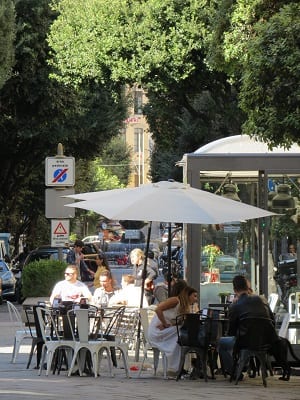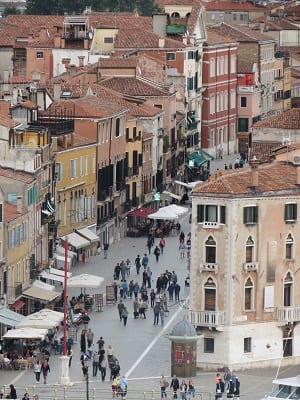Italy is one of the leading countries in fashion design and Italians are passionate about clothes and trends and dress up pretty much for any given occasion. In Italy people like to wear elegant and sleek outfits to parties and to the office, but they are always careful to be at their best even when they are going out for a short walk or even when they go to the supermarket because appearance is considered a form of art.
Italians like to notice what others are wearing and like to be noticed at all times but this becomes particularly true on weekends.
 Italian street ‘invaded’ by pedestrians
Italian street ‘invaded’ by pedestrians
Every Saturday afternoon, in all Italian cities, people gather downtown for the so-called ‘struscio,’ which consists of walking up and down the main pedestrian area of the city, usually called Corso Italia (Avenue Italia), wearing the best possible outfit and hoping to be positively noticed by others.
The struscio is a quiet slow-paced stroll which may or may not involve some window shopping and a brief stop at a local café for a quick espresso and it is the main informal Italian social event.
This stroll is called struscio (literally: rubbing) because there are always two groups of people walking up and down the street in opposite directions, therefore ‘rubbing elbows’ with the other passers-by, on a road closed to traffic where pedestrians take the lead.
Every Saturday afternoon the main Corso is literally invaded by people who gather in the heart of the city to spend hours completely carefree, talking with friends and hoping to meet new people. In the smaller towns where almost everyone knows everyone, people stop and chat along the stroll and bump into friends and this occasion becomes also a great way to extend the circle of acquaintances.
 Sometimes the ‘struscio’ continues after dark
Sometimes the ‘struscio’ continues after dark
Even people who live in the outskirts come by public transport or by car to spend a few hours people-watching and ‘bathing’ in the crowd. During the ‘struscio’ people like to show off their designer jeans or the trendy new jacket they have just purchased. For young people, it is a time of aggregation and it represents a real opportunity to exchange ideas and opinions with their peers. The elderly participate in the ‘struscio’ by taking a sidewalk table at a local café to watch people walk by and comment on their outfits and haircuts.
For people of all ages watching passers-by is also a great way to discover the new trends of the upcoming fashion season. Following trends and styles is important for Italians because they love to feel they belong and like to own what others own. More so than in other cultures, clothes in Italy represent a status symbol and owning a particular brand can easily place you in a section of society or another and tell others a lot about your personality, habits and preferences. Fashion in Italy becomes therefore a form of silent communication.
 sidewalk tables at a local café
sidewalk tables at a local café
 Italian streets are perfect for strolling
Italian streets are perfect for strolling
In the past, the struscio was a way for young girls and boys to meet under the watchful eye of their families; nowadays, Italian families are more liberal and teenagers are free to walk and ride around on their scooters without any supervision.
This ‘ritual’ stroll dates indeed back to the 19th century when during the weeks preceding the Holy Easter a ban on horses and chariots was imposed. During this Holy Period, people who observed the rite of walking to visits the churches were forced to circulate on foot along the main city street and, given the large number of people attending the ritual walk, the pace was slow and they often ended up rubbing against each other. Young people especially used to look forward to these days to receive new clothes to wear from their parents, however, clothes back then were never supposed to be too fancy or too flashy and the struscio was not the informal fashion show it is today.
































































